
Sony Reader: Mammal or Dinosaur?
August 20, 2007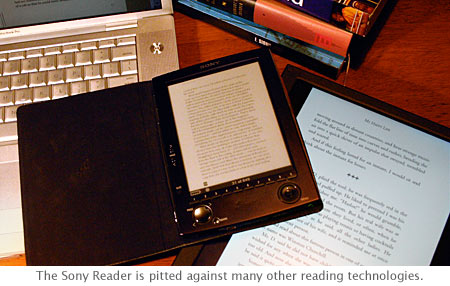
A branch in the evolutionary tree of digital devices will inevitably yield a machine that largely displaces the paper and ink of printed books. We clearly haven’t seen this ultimate device yet, but the Sony Reader and its dedicated-reader cousins represent one order of critters competing for this niche in the digital food chain, sandwiched between larger and more powerful general purpose computers (like the Lenovo X61T tablet) and the smaller, nimbler mobiles (like the iPhone).
In the accelerated-Darwinian world of consumer devices, the marketplace may have already decided the success of this particular Sony model (i.e., not a huge amount of traction so far) and much has already been written about its qualities. Nevertheless, I wanted to see for myself the current state of dedicated-reader evolution, especially in comparison with the other competing device types. It’s also a preview of the future, as new devices are set to emerge from Cybook and perhaps even Amazon. I’ve only had the unit for a few days, so it’s too soon to talk in-depth but I’ll cover my out-of-the-box reactions.
First Impressions
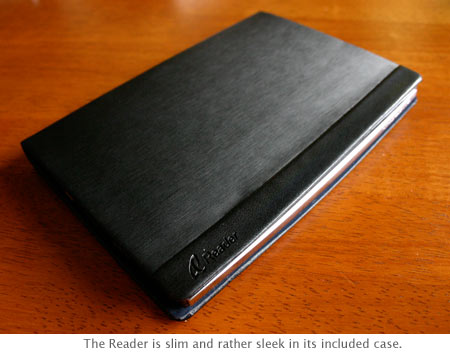
My first reaction was surprise — I’d forgotten just how compact this machine really is. After a few weeks of reading with the Lenovo, the difference was stark. As light as the tablet is for a laptop, the Sony — at less than a pound — is less than a quarter of the weight and a third smaller in every dimension. 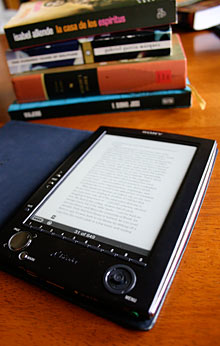 Its tiny and very totable physical size put a powerful exclamation point on the portability potential of ebooks — the old notion of a shelf full of titles in a package smaller than a trade paperback is realized here, and it’s a very attractive feature. I originally thought that carrying this device in addition to a primary laptop would be excessive, but in reality, it would be a practical option with little additional stress on my overburdened messenger bag (or my back!).
Its tiny and very totable physical size put a powerful exclamation point on the portability potential of ebooks — the old notion of a shelf full of titles in a package smaller than a trade paperback is realized here, and it’s a very attractive feature. I originally thought that carrying this device in addition to a primary laptop would be excessive, but in reality, it would be a practical option with little additional stress on my overburdened messenger bag (or my back!).
Touchy Pleasures
Since the experience of reading a digital book is often compared against the tactile and visceral pleasures of handling its printed counterpart, the Sony’s physical design may have almost as much influence on the machine’s success as its book-reading functionality. In this respect, the machine is a mixed success. The fabric and leather-like folding case is pleasant to hold, with a magnetic latch that gives it a bit of substance when closed. The machine’s exterior plastics — a lightly-speckled black with chrome vertical edges — look solid and have a good feel in-hand. Unfortunately, the controls aren’t as successful. The joystick at the bottom right feels uncomfortably sharp-edged and rough to the touch. The other controls are less unpleasant, but they can be confusing in their functions and generally need polish in their appearance, positioning, and feel.
The Visuals
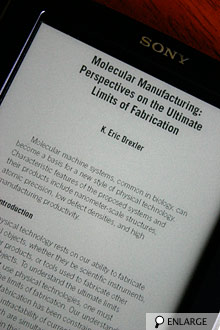 The display is the make-or-break part of any ebook reader, and the Sony’s e-ink screen is dramatically different from the LCD-based competition. In bright, indirect light, the display is beautiful, with a matte paper-like appearance. With a higher resolution and non-glowing surface, the page feels more comfortable and natural to the eye than a standard laptop LCD under these conditions. In less-ideal settings with dim artificial light, the screen’s apparent contrast degrades and takes on the hue of the light source, becoming harder to read. To be fair, a print book would also suffer in similar conditions but the Sony absolutely requires good light.
The display is the make-or-break part of any ebook reader, and the Sony’s e-ink screen is dramatically different from the LCD-based competition. In bright, indirect light, the display is beautiful, with a matte paper-like appearance. With a higher resolution and non-glowing surface, the page feels more comfortable and natural to the eye than a standard laptop LCD under these conditions. In less-ideal settings with dim artificial light, the screen’s apparent contrast degrades and takes on the hue of the light source, becoming harder to read. To be fair, a print book would also suffer in similar conditions but the Sony absolutely requires good light.
The photo above shows K. Eric Drexler’s The Engines of Creation 2.0 in PDF format. Some content like that in Sony’s proprietary format can be reflowed like an html page, but those in the ubiquitous PDF format typically have fixed pages limited by the hardware’s ability to zoom. Because of this, the sans-serif font in this example is legible but a bit thin and small, even in the Sony’s zoomed-in mode. However, a landscape orientation mode is available, allowing more magnification for a given page size. The photo below shows H.G. Wells’ The War of the Worlds in this view. The increased magnification combined with a heavier serif font makes for a much more comfortable read.
Despite some compromises, the Sony is clearly optimized for text. In contrast, graphical content like the Lullaby comic below is an insurmountable challenge. The balloon text is rendered nearly illegible and the rich colored graphics are reduced to a splotchy, dithered murk in the e-ink’s four shades of gray. The display is simply not up to the task of showing this kind of content.
So, given this first look, is the Sony Reader a mammal or a dinosaur in the evolution of ebook-reading devices? While the current limitations of the display technology (color is expected to be available in two years or so) and design problems with this particular species, the idea of a very compact, long-lived ebook reader continues to be a competitive one which may yet spawn an ideal device in later generations. I will continue to use the Sony for a long-term test to see how well adapted it really is — and I’ll compare its qualities from a reader’s perspective with those of its tablet PC and iPhone competition. Stay tuned!
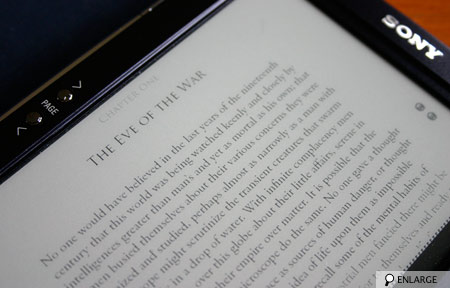


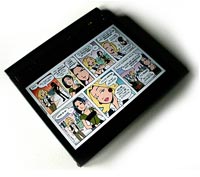








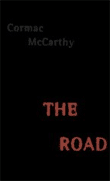

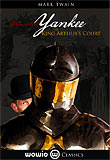



[…] is largely in line with my own continuing experience with the earlier PRS-500 model. I still gawk at the e-ink screen with wonder, though I am at times […]
I am hoping both the Sony Reader and the Amazon Kindle will come down in price to $100 so more college students and people like me who love new technology can go ahead and buy one of those OR something very similar from Apple or whoever is willing to take the leap into e-Book technology! I also hope Apple iWork and Microsoft Word will have a plug-in that lets you create your own e-Book to upload to a publisher to sell to people OR just create free e-Books to enjoy! – Mark McLaughlin /marknetproductions.wordpress.com / Hudson, MA, USA
hudsonman35, I totally agree with you. I love this little gadget, but not with it’s $300+ price tag. I am resisting just rushing out and buying this baby, but I’m really fighting.
The price of ebook reader is very constrained by the eink panel. E-ink is now really monopolized by a single firm. So, I guess there will unlikely such price cut in near future.
has anyone compared the Sony to the Kindle? Seems the down load feature on the the Kindle is superior to Sony. (No need to hook up to your computer) Also Kindle’s store is Amazon, so I’d guess there are more titles available there. Finally, has anyone heard when is Kindle coming to Canada?
I have a mac, & and iphone, and a Sony Reader 505. While I have never actually held a Kindle, from comparisons I’ve read, I am pretty sure that from a physical and operational viewpoint, I prefer the Reader.
But the problem is that the Reader doesn’t prefer my Mac. So I can’t buy books at the Sony Bookstore. Further, although some DRMed files, like Adobe, will work on my 505, in order to make that happen, I have to find someone with a PC to do the proper authorizations, even when I’ve managed to buy the Adobe file & download it to my mac.
I am reluctantly being driven to the conclusion that the best combination of ebook reader and iphone reader for a mac owner is Kindle based rather than Sony based. I’ve tried using calibre, Stanza & Stanza Desktop, which combine to give me an iphone reader which will work with the 505. But compared to the Sony Bookstore and more particularly, Amazon, the ebook selection is sparse – even taking into account the books that are in the public domain.
I like the 505, and might keep it as well, mainly as a dedicated newspaper & magazine reader, thanks to calibre. In addition to being able to download 505 ready newspapers/magazines from the internet, an add-on called Bookit permits one-click downloading of web pages into calibre, converted to an epub file suitable for reading on the 505.
Of course, if Apple ever decides to make a king sized Touch, all bets might be off. I think it would be the killer ebook reader.
[…] many of the graphics and usability issues that severely limited the comics-reading utility of the monochrome e-readers and bulky tablet PCs that came […]